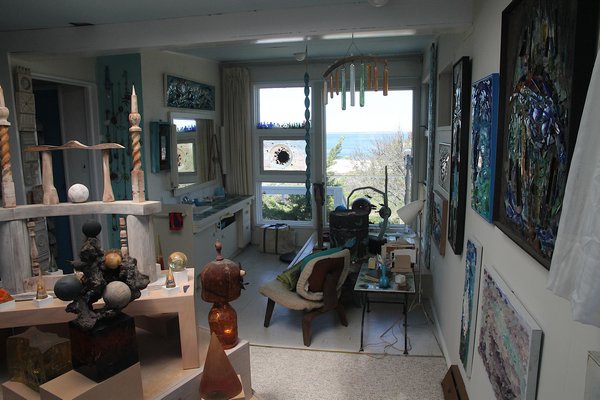
It is a sunny and buoyant Mother’s Day and I am sitting on a small beach, a spit of land in Napeague overlooking Hicks Island. A windsurfer glides by. Some seagulls swoop down and disappear as well. Behind me stands Mabel and Victor D’Amico’s home—the Mabel and Victor D’Amico Studio and Archive—a framed white house almost 75 years old.
While this is the day to contemplate my own parent who had left me an inspiring world view and valuable lessons, I am also remembering the D’Amicos, a symbolic mother and father to thousands of art students and instructors who taught about life and values: a belief that the arts are a humanizing force which vitalizes all aspects of being alive.
The D’Amicos had formed a perfect collaboration when they started their lifelong commitment to art education. Mr. D’Amico was the first director of education at the Museum of Modern Art from 1937 to 1970, developing a program for children, parents and adults, including war veterans and other community members. Ms. D’Amico had headed the art department at the Rye, New York, high school and was an experienced nature pioneer.
In 1940, they bought a house at Napeague’s Lazy Point area that was to be demolished; both had become intrigued with the quaint locale, filled with old fishermen’s cottages and diverse landscape of wetlands, inlets and shorelines. It was certainly the farthest location possible from Manhattan’s MOMA on West 53rd Street. No crowds, traffic and buildings. Only beach grass, bushes and sand.
While the setting was ideal, the deconstruction of the original structure on-site was not. The building consisted of a series of beams and little else. As a result, the couple had to put a tarp over the beams and ended up camping out the first summer. Resources were also scarce, due to World War II. The D’Amicos had to use both old wood and nails, dislodging the nails from the original house and hammering them straight.
However, the results were admirable. They had managed to build one of the first modern homes in the area, and they had done it practically all by themselves. Yet the D’Amicos were not finished with their construction projects. Mr. D’Amico found a way to also build an art school in a unique setting nearby, locating a World War 1, 500-ton Navy barge in an abandoned New Jersey harbor. In 1960, he and some local fishermen towed it up the East River, through Hell’s Gate and into Long Island Sound to the shore of Napeague Harbor. Thus The Art Barge was born, still serving each summer as a flourishing art school with a second story and lots of studio space.
Originally, studio painting and teacher training classes were taught by Mr. D’Amico. Soon, Ms. D’Amico joined her husband and other instructors. This 2014 season proves how the program has grown, with diverse courses for children and adults in watercolor, collage, photography and other media.
What has not changed is the interior of the D’Amico home, even though Mr. D’Amico died in 1987 and Ms. D’Amico in 1998. Christopher Kohan, president of The Art Barge’s Board of Trustees, knows all about this kind of continuity. Mr. Kohan first started taking classes in 1975 at The Art Barge. In 1979, Mr. D’Amico offered him free accommodations in exchange for his helping at The Barge, where Mr. Kohan soon became a jack of all trades, as well as a decades-long resident of a small cottage next to the D’Amico house.
Now living in a larger place across the road, he is a devoted protector of the D’Amico property, which today is owned by the Victor D’Amico Institute of Art, The Art Barge and its board of directors. He can attest to the home’s stability during three hurricanes, including one in which Ms. D’Amico resisted evacuation. (When firemen pounded on the door to warn her and Mr. Kohan of the impending danger, Mr. Kohan and Ms. D’Amico preferred to finish their wine before leaving.)
In addition to supervising classes at The Art Barge, Mr. Kohan oversees tours of the D’Amico home. They are both fascinating and instructive, with Ms. D’Amico’s bold, handmade jewelry on display in an upstairs bedroom, and can be scheduled by calling The Art Barge at (631) 267-3172.
Curiously, the work at the house, informal as it is, resembles an art installation, where beautiful works made with found objects preserve the Modernist style.
There’s is one room serving as an office where Ms. D’Amico’s sculptures stand. The pieces are both abstract and realistic, created again with found objects and old wood.
Equally striking, perhaps, is how the home’s inside and outside form a symbiotic relationship. From the many glass windows, one can both see and experience nature’s gifts—the water, the horizon, sculptures scattered around the grounds. Nature’s presence also pervades the interior art works, particularly Ms. D’Amico’s glass bottles and wood sculpture. It’s easy to imagine life as the D’Amicos lived it, sitting in their very own black chairs and enjoying the view as they once did.
Yet with its natural environment intact, there are also very practical aspects to the house, like a cabinet in the office where found objects are kept. Kitchen drawers, arranged vertically, can be pulled out from the wall. The couple knew how to maximize the sparse space, adding beautiful design elements.
Mr. Kohan wants to document and digitize items in the archives like old catalogs, drawings and pictures. Important as well to him is the pair’s commitment to teacher education, and he plans to expand the program, conveying the couple’s basic principles. “Art encourages individuals to develop an ability to learn about themselves. Art is autobiography,” he said.
Asked about the personal connection between him and his mentors, in light of its being Mother’s Day, Mr. Kohan answered without hesitation:
“My parents gave me life,” he said. “Mabel and Victor gave me something to do with it.”